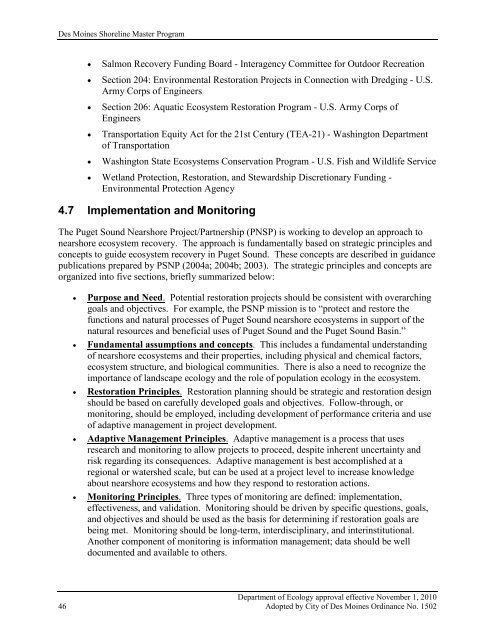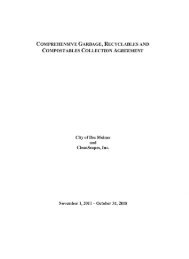CITY OF DES MOINES SHORELINE MASTER PROGRAM
CITY OF DES MOINES SHORELINE MASTER PROGRAM
CITY OF DES MOINES SHORELINE MASTER PROGRAM
Create successful ePaper yourself
Turn your PDF publications into a flip-book with our unique Google optimized e-Paper software.
Des Moines Shoreline Master Program<br />
• Salmon Recovery Funding Board - Interagency Committee for Outdoor Recreation<br />
• Section 204: Environmental Restoration Projects in Connection with Dredging - U.S.<br />
Army Corps of Engineers<br />
• Section 206: Aquatic Ecosystem Restoration Program - U.S. Army Corps of<br />
Engineers<br />
• Transportation Equity Act for the 21st Century (TEA-21) - Washington Department<br />
of Transportation<br />
• Washington State Ecosystems Conservation Program - U.S. Fish and Wildlife Service<br />
• Wetland Protection, Restoration, and Stewardship Discretionary Funding -<br />
Environmental Protection Agency<br />
4.7 Implementation and Monitoring<br />
The Puget Sound Nearshore Project/Partnership (PNSP) is working to develop an approach to<br />
nearshore ecosystem recovery. The approach is fundamentally based on strategic principles and<br />
concepts to guide ecosystem recovery in Puget Sound. These concepts are described in guidance<br />
publications prepared by PSNP (2004a; 2004b; 2003). The strategic principles and concepts are<br />
organized into five sections, briefly summarized below:<br />
• Purpose and Need. Potential restoration projects should be consistent with overarching<br />
goals and objectives. For example, the PSNP mission is to “protect and restore the<br />
functions and natural processes of Puget Sound nearshore ecosystems in support of the<br />
natural resources and beneficial uses of Puget Sound and the Puget Sound Basin.”<br />
• Fundamental assumptions and concepts. This includes a fundamental understanding<br />
of nearshore ecosystems and their properties, including physical and chemical factors,<br />
ecosystem structure, and biological communities. There is also a need to recognize the<br />
importance of landscape ecology and the role of population ecology in the ecosystem.<br />
• Restoration Principles. Restoration planning should be strategic and restoration design<br />
should be based on carefully developed goals and objectives. Follow-through, or<br />
monitoring, should be employed, including development of performance criteria and use<br />
of adaptive management in project development.<br />
• Adaptive Management Principles. Adaptive management is a process that uses<br />
research and monitoring to allow projects to proceed, despite inherent uncertainty and<br />
risk regarding its consequences. Adaptive management is best accomplished at a<br />
regional or watershed scale, but can be used at a project level to increase knowledge<br />
about nearshore ecosystems and how they respond to restoration actions.<br />
• Monitoring Principles. Three types of monitoring are defined: implementation,<br />
effectiveness, and validation. Monitoring should be driven by specific questions, goals,<br />
and objectives and should be used as the basis for determining if restoration goals are<br />
being met. Monitoring should be long-term, interdisciplinary, and interinstitutional.<br />
Another component of monitoring is information management; data should be well<br />
documented and available to others.<br />
Department of Ecology approval effective November 1, 2010<br />
46 Adopted by City of Des Moines Ordinance No. 1502



